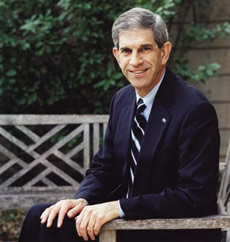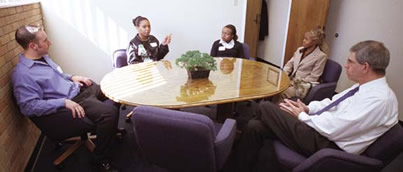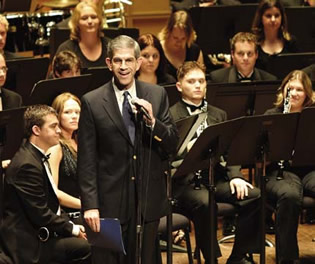| First African American graduate | Dunlop photo collection | Alumnae get tough |
 |
||
| Home Forethought Campus Buzz Feature Stories Re:Search The Score Alum News Yesteryear | ||
 It's been a whirlwind few months for UTA President James D. Spaniolo. High-level meetings with high-profile officials, press conferences, receptions, luncheons, dinners, banquets, lectures. Name an event, and he has probably been there.
It's been a whirlwind few months for UTA President James D. Spaniolo. High-level meetings with high-profile officials, press conferences, receptions, luncheons, dinners, banquets, lectures. Name an event, and he has probably been there.
Public appearances aside, the everyday duties of running a multifaceted university that he's still learning about should be overwhelming. "It must be like drinking from a fire hose," somebody told him shortly after he took office Feb. 1.
He's not spilling a drop.
Spaniolo quickly began building an administrative team by naming a provost and several vice presidents. He participated in corporate agreements--with Vought Aircraft Industries and Sandia National Laboratories--that have far-reaching implications. These partnerships were in the works before he became president, but they underscore his emphasis on collaboration.
He also has established himself as a communicator. If there's major news, he tells the entire University via e-mail. He has sent four messages so far, including a greeting his first day on the job.
"It's important to expect great things to happen at UTA because I know already that there is greatness within our University," he wrote. "I've seen it in the women and men I've met so far. And I expect to see much more greatness in the months ahead."
UTA Magazine caught up with President Spaniolo for a look at his first 90 days and a glimpse at what lies ahead.
From your point of view as a Michigan native, is Texas hospitality all it's cracked up to be?
My wife, Sally, and I have been welcomed with great kindness and friendship. It's amazing to think that a year ago we had never been to Arlington and had not seen UTA's beautiful campus. Today we feel right at home in Arlington, at UTA and in Texas. In our first conversation, President Emeritus Nedderman advised me that all you need to become a Texan is to be willing. I am willing!
Does that willingness include buying a pair of cowboy boots?
Yes. In fact, I wore them at the investiture, and I plan to break them in working to make UTA even greater than it already is. And I hope to acquire some additional boots along the way.
Some might add that to be a true Texan, you must love Mexican food. Have you developed a taste for Tex-Mex yet?
Yes, I have. And I plan to sample several more varieties in the next few months.
 |
| SUPPORTING STUDENT LIFE: President Spaniolo throws out the ceremonial first pitch during a game against Oklahoma State University at Clay Gould Ballpark. His strike set the stage for a pitcher's duel won by UTA, 1-0. |
I've concentrated on reaching out to UTA's stakeholders because their opinions and insights will help shape our University's future. Sam Rayburn, the legendary Texas congressman who was a former speaker of the U.S. House of Representatives, once said that if you're not listening, you're not learning. Thus far I've been doing a great deal of listening--and learning.
What have you learned?
I've learned that UTA is an outstanding university with strong traditions. There are significant strengths and great expertise across the University. Every day I learn more about our accomplishments. For example, an accrediting team described the School of Architecture as one of the strongest design schools in the country. In March, the College of Business Administration conferred M.B.A. degrees on 95 senior executives in Beijing, China. Our program is the largest of any American university in China. The School of Urban and Public Affairs, the School of Social Work and the School of Nursing were rated highly in the recent U.S. News & World Report rankings. And the colleges of Engineering and Science are central to new corporate and national laboratory partnerships with our cutting-edge research in nanotechnology playing a critical role. These are four very recent examples. There are many others.
You've no doubt also learned that UTA's location is one of its biggest strengths.
I recently saw a sign in Arlington that said, "We are first in the heart of the Metroplex." It struck me as a perfect way to view our University. We are in the heart of the Metroplex, an equal distance between Dallas and Fort Worth. We are a most valuable asset and partner, not only for Arlington but also for those in Fort Worth and Dallas. UTA must see itself and be seen as a powerful resource for education, innovation, knowledge generation, technological discovery and economic development. We are an engine for advancement. We must take full advantage of our strategic strengths and location.
| UP CLOSE with Jim Spaniolo |
|
Wife: Sally Spaniolo Children: Jamie, 26, client manager for CreateHope, Washington, D.C.; Sarah, 23, production assistant for the Discovery Channel, Washington, D.C. Parents: Victor G. Spaniolo, newspaper publisher, died in 1997 at age 80; Eleanor F. Spaniolo, lives in South Bend, Ind. Siblings: Tom Spaniolo, immigration lawyer, Portland, Ore.; Margaret Spaniolo, senior vice president at Bergdorf Goodman, New York, N.Y.; Virginia Spaniolo, real estate broker, St. Paul, Minn. College education: Bachelor's degree in political science from Michigan State University, master's degree in public administration from The University of Michigan, juris doctorate from The University of Michigan Law School. High school education: Graduated from Cassopolis (Mich.) High School in 1964. My advice to a graduating high school senior: Work hard, follow your dreams and never, ever give up. My heroes: (in alphabetical order) former Knight Ridder CEO James K. Batten, Billy Graham, John F. Kennedy, Martin Luther King Jr., Clifton R. Wharton Jr. My greatest day: Professionally, Nov. 19, 2003, the day the Board of Regents selected me to be president of UTA. My credo for life: Make a difference in the lives of the people with whom you live and work. |
I want to build an even stronger relationship with Fort Worth and increase UTA's presence in Tarrant County. I look forward to strengthening and expanding our partnership with Tarrant County College and to building new partnerships with Texas Christian University, the University of North Texas Health Science Center and Texas Wesleyan University. The synergy we can create by working together can transform higher education in our region. That's not to say we'll be ignoring Dallas. We won't. There are many opportunities there as well. Again, we need to remember that we are in the heart of the Metroplex.
You speak often of partnerships and collaborations. Why is this approach so important?
We are ideally positioned to build partnerships and collaborations that will enhance the University as we strengthen our communities. Our recent agreement to establish a research and teaching partnership with Vought Aircraft Industries is an excellent example. This partnership will provide benefits not only to UTA and Vought, but it will contribute to the economic prosperity of Texas. We also need to build stronger collaborative relationships with other universities, including those in The University of Texas System. I'm pleased that we're collaborating on an $18 million medical imaging research project with U.T. Dallas and U.T. Southwestern Medical Center. And in March, our three universities agreed to develop collaborative research projects with Sandia National Labs that could lead to breakthroughs in homeland security research. I strongly believe that our fellow universities and medical components should be our collaborators--not our competitors.
What role will partnerships with the city of Arlington play?
They are crucial to our relationship with Arlington. We already have several key collaborations under way, including the new Center for Continuing Education and Workforce Development, which opened in May, and the Arlington Technology Incubator. We are also working closely with the city and the Arlington Chamber of Commerce to develop a new commercial and retail presence close to the campus. That success and other similar efforts will enhance both the city and UTA.
How does the concept of collaboration apply within the University itself?
Partnerships and collaborations on campus are critical. They are critical to academics as we build more and more multidisciplinary and even multi-institutional programs. And they are critical in student and residential life as we create a richer, more vibrant environment that draws more people to campus.
With more students living on campus, do you think UTA's image is changing?
UTA is not the so-called "commuter school" it may have been at one time. As you said, more students are living on or immediately adjacent to the campus. In the fall, we expect approximately 5,000 students to live in university housing. We're creating living-learning communities such as K.C. Hall, opening this fall, that combine rigorous academic, community outreach and service, and faculty mentoring components in a student residential environment.
 |
| LISTENING AND LEARNING: The president meets with students in his office. He has spent much of his first few months seeking the opinions and insights of alumni, faculty, staff, students and other UTA stakeholders. |
a vibrant campus life?
At their best, athletics are a source of pride in the University and in our student-athletes. They give us an opportunity to express our school spirit and constructively engage our competitive instincts. But athletics are not the only way to create a vibrant campus life. The arts--music, dance, theater, cultural activities and events--and political discussion and debate also contribute to the richness of life on campus. Personally, I believe it's all of these activities taken together that make life on a university campus so special. (See p. 33 for details on the referendum to add football, women's golf and women's soccer.)
You're a sports fan yourself, right?
Sally and I are big intercollegiate sports fans. We enjoyed men's and women's basketball and volleyball at Michigan State and were season ticket-holders for football. When we lived in Miami, we attended many University of Miami baseball games. So we like sports. We also enjoy the performing arts-theater, dance and the symphony. We love American history and look forward to learning much more about Texas history, culture and customs.
Have you seen the Alamo--either the movie or the mission in San Antonio?
We visited the Alamo when we accompanied the MSU basketball team to the NCAA Tournament in 2003. We found it fascinating. Like most others, we haven't seen the movie yet.
 |
| REACHING OUT: Spaniolo addresses the audience at music Professor Ray Lichtenwalter's retirement concert at the Morton H. Meyerson Symphony Center in Dallas. The UTA Wind Ensemble and Concert Band performed. |
I was a communications law specialist with a strong interest in First Amendment law. Although I never argued a case before the U.S. Supreme Court, I did have the opportunity to write a brief in an important First Amendment case that was cited in the court's opinion. That was certainly a highlight.
What would you say to those who might be concerned that you haven't spent your entire career in academia?
Given the environment that public universities find themselves in today, I think it's an advantage to have had a variety of professional experiences outside the academy before becoming a university president. So on balance, I think it's a plus. It's also important to remember that I'm no stranger to higher education. Over the past 35 years, I've served as an assistant to the president of a major university and for the past seven years was dean of a large college at that same major research university. In addition, I've served on the Governor's Commission on Higher Education in Michigan and headed up a Sloan Foundation-funded task force that studied the financing of higher education. Taken together, all of these experiences--inside and outside of higher education--have prepared me to be a university president.
How do you view the role of president?
Well, hopefully not like what happened at the Alamo. I believe that presidential leadership must be collaborative and connected with both the capacities and the aspirations of the entire university community. It's not the president's personal vision but our shared vision that emerges from strategic conversations and consultation with all those who care about our University. That includes our elected representatives, whose support is so important to us. This will not be a solitary exercise.
How will you measure your success?
The success of any university president can't be separated from the excellence and accomplishments of the university's students, faculty and staff. Knowledge is the product universities provide, but our students and graduates are our prize. We are only as strong as our student success. We are only as vibrant as our faculty scholarship and research. We are only as relevant as our impact on the state's vitality. My pledge to everyone who cares about UTA is that we will be strong and vibrant and relevant during my tenure, and we will work together to make it so. We take pride in saying, "Expect great things." I say we should expect even greater things of each other because our best days lie ahead.
Interview by Mark Permenter
| Archives
| Alumni Association |
Giving to UTA | UTA
Home Copyright © 2004 UTA Magazine. All rights reserved. |